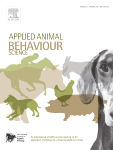Document type : scientific article published in Applied Animal Behaviour Science
Authors: Alexandra C. Green, Cameron E.F. Clark, Sabrina Lomax, Livio Favaro, David Reby
Preview: Context-related information can be reflected within mammalian vocalisations and could in turn be studied to benefit production animals. Whilst previous research has revealed the contextual, and even emotional content of goat, pig and horse vocalisations, cattle vocalisations remain relatively less explored. In this study we recorded the vocalisations and accompanying phonatory behaviours of 19 Holstein-Friesian dairy cows (n = 10 primiparous, n = 9 multiparous) during the peripartum contexts of parturition with dystocia and fence-line calf separation. Findings revealed that vocal structure was context dependent, with parturition calls longer in duration, higher in fundamental frequency (F0) min and F0 start, containing more nonlinear phenomena and more minor F0 modulations. By contrast, calls during calf separation were distinguishable by their F0 contour, having a higher F0 mean and F0 max, and greater F0 var, F0 cv and F0 absolute slope. During parturition, primiparous cows emitted calls longer in duration, lower in F0 mean, and containing more F0 modulations than their multiparous conspecifics. Parturient cows expressed a greater number of open mouth calls, whereas mixed calls were more common in the calf separation context. Additionally, 82 % of the primiparous and 10 % of the multiparous cow vocalisations involved tongue exposure from the mouth during parturition, which may represent a visual indicator of compromised welfare. Overall, our results show that the context-related variation is conveyed through an integration of vocal and visual sensory modalities, with the combination of an open mouth configuration, tongue protrusion, and spectrographic properties such as an overall lower F0 and longer duration during parturition likely enhancing vocal transmission over longer distances to inform more receivers about the urgency of this context. Knowledge of these vocal and behavioural cues could be adopted on farm to determine the welfare of peripartum cattle and are instrumental for future cattle bioacoustics research.




